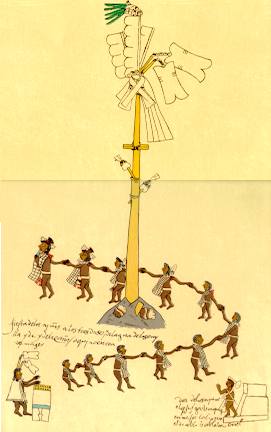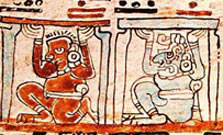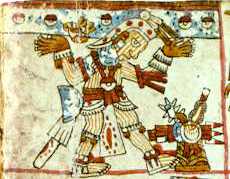|
|
|||
|
|
|||
|
|
|||
|
|
|||
| Perhaps
no other society is as renowned for its obsession with the symbolizing
of axis and center as are the old Precolumbian cultures. In all of these
cultures' manifestations, those symbols are present, expressed in the four
directions of space and time, as well as in the fifth, equidistant and
central point-which is both their origin and their locus of convergence-marking
the vertical, above and below, heaven and earth, direction. Alfonso Caso
tells us:
In the myth of the founding of the Inca Empire, an ancestral pair, Manco Capac and Mama Ocllo, after a laborious journey-a pilgrimage favored by the sun, which had bestowed upon them a golden staff (symbol of the axis)-succeeded in plunging it without difficulty in a magical, precise place where, according to their star, they were to remain, since this would be their center, the place where they were to found and develop their empire. The sign had been produced, then, and it showed the conjunction of heaven and earth, by the verticality of the staff as masculine factor, and horizontal receptivity of the earth as feminine component. At this mythical spot, then, which according to certain legends turned out to be Cuzco, was manifested the confluence of two energies that suffered no contradiction-as it had been prophesied-resulting in a reconciliation of opposites that facilitated the irruption of the celestial, divine, axial energy. This irruption took the form of emanations that, by way of the toil of this people, heirs of the sun, could be extended in the four directions of space and throughout all cyclic time, the latter being marked as well by the quaternary of the seasons of the year, of the great eras of the world-in association with the four states of matter-or of the hours of the day.3
Primordial time-ab origine, illo tempore-in which [this people's] new existence elapses, will unfold, beginning with the manifestation of the portentous god, in a sequence culminating in sacred space, in the region of the lakes.4 The Sacred and the Profane We have seen that the vertical axis, located at the center, acts as an intermediary, effecting the heaven-earth, or above-below, relationship, and that it is symbolized by the tree, the rock (the mountain in miniature), the temple, and specifically in Mesoamerica, the pyramid. It falls to man to be the highest and most complete exponent of verticality, since it is he who crowns and finishes creation: he conjoins within himself the energies of the heavenly and the earthly, and it is through his mediation that the cosmos is perennially re-created. We have already indicated that, for native civilizations, the world was a plane, with a quadrangular base, surrounded by a sea. It was a kind of island. The surrounding sea fused, in the horizon, with the dome of heaven ("the celestial waters of the divine sea"). Beneath this earth-in some cases supported by columns, gods, or giants-is the lower world, the region of the dead. As we have already emphasized, this conception makes it plain that Precolumbian thought was the same as that of the traditions of the Old World and Antiquity. In fact, this conception of the earth as a plane surface is maintained almost unanimously by the first Fathers of Christianity (third, fourth, and fifth centuries), by Saint Clement of Alexandria, Saint Basil, Saint John Chrysostom, Saint Ambrose, Lactantius, and so on, and is inherited from the Greek tradition as well as from other civilizations. In any case the American tradition is not unique (although it is certainly "characteristic"-that is, autochthonous). It appears rather that all known versions of these symbols and myths are adaptations of a single nonhistorical event woven into the tissue of the human being. The number five, which is at the basis of the Precolumbian cosmogony-the four cardinal points and the center or quintessence-is, by definition, the numeral of man, the microcosm for Western symbolism, as well as the place of the Emperor (as mediator, governor, and administrator) in Chinese tradition. And this human being, image of the vertical, is dual, existing entirely between two poles, the highest and the lowest, the heavenly and the earthly, the divine and the human, the vertical and the horizontal, the sacred and the profane-which, like any pair of opposites that only seem to be contradictory, must have a common, unitary point at which they join. The sacred and the profane are but two different ways of seeing a single reality, by noting or underscoring particular characteristics that accord with our vision. That power is within man. It falls to him to sacralize or profane the world and life, to know of the high and the low, and of the profound cosmogonic mysteries enwrapped in the ideas symbolized by heaven and earth, ideas understandable and knowable by man thanks to the fact that they are present in his consciousness, in his interior, mental space. It is the human being, then, who has the capacity to hear and know of the celestial energies, recognize the gods revealed to him, and observe their commands on earth by way of a series of adaptations. This inspiration, or aspiration, of divine emanations, and their expiration into the world, this reconversion of the vertical into the horizontal-if we might be permitted the expression-is what has always shaped cultures, which constantly reiterate the sacrality of their origins and their knowledge of a reality of another, invisible and more elevated, plane. This reality is experienced as antecedent, or as having elapsed in an atemporal time-customarily designated the City, the Palace, or the Heavenly Temple, which are the prototypes of the earthly city, palace, and temple.6 Each human being is the visible image of a Universal Being, which at the same time is within, or represented by, that person, and the life and body which the person uses in the earthly abode are illusory. We only come to sleep, we only come to dream. It is not true, it is not true That we come to live on earth!7
Nor is the sacred a sanctimoniousness, a religiosity, or superstition. It is not tied exclusively to a moral theory and to behaviors in conformity with coercive laws. Indeed, at times it contains something of the abnormal, and presents itself in monstrous (disease, insanity, misfortune) or even grotesque form. In a sense, this is revealed in taboo and its object, a reality which we find marked by a false-to an outsider-aura, like anything else that might be "antinatural." The sacred exists at the heart of the consciousness of man who shares in Universal Being, and yet this state, this reality, is as difficult to describe as the nature of precisely what it expresses (which is tantamount to his identity). Perhaps one might assert the sacred by way of denying all that it is not. But we shall have to take very much into account that the holy is not only a "feeling," as is claimed, nor a fantasy, as is suspected, nor a "virtue," as is imagined. The reality of the sacred, its truth, is deduced from the falseness of the profane, from its inefficacy. One thinks of health when experiencing illness. It is thanks to creation that we conceive the uncreated. Essence is immanent in substance. A traditional conception of sacrality is intimately connected with the knowledge of other levels or worlds, which are experienced as real, and are not outside man as if they constituted other physical worlds or places, but are found at the core of his consciousness, by which he can perceive them, since they present themselves as identical with himself, as if they were his authentic being, the Universal Being that is his origin and destiny, and from which all men and things emanate, to return to Him indefinitely. This change, this return to Universal Being, is the man's task as administrator of creation. And rite and symbol are the vehicles employed in traditional societies for building a bridge between the fleeting and the permanent, between ignorance and knowledge. All of the culture of the traditional person, translated into everyday rites and daily symbols, is but a continuous memorial, in gesture and mind, of the invisible plane, of the sacrality of the world, and a constant offering of thanks and reverence to the deity, to the numina that are perpetually generating us. No contrary thought has ever found a place in a traditional society,8 which extracts all of its knowledge from the apprehension of these archetypal truths that constitute its cosmogony-its way of seeing the one cosmogony. It is thanks to its cosmogony that such a society can organize and live in freedom and prosperity-according to the measure of its opportunities-and possess an identity that will translate into its daily activities, its labors, its social, family, and individual occupations, its festivals and games, its social organization, its writing and calendars, its gods, its myths and symbols-in sum, into its culture as a gigantic total rite. |


